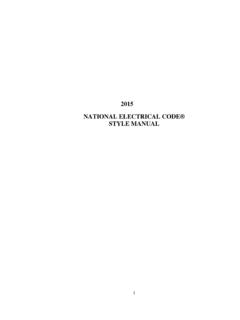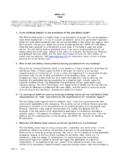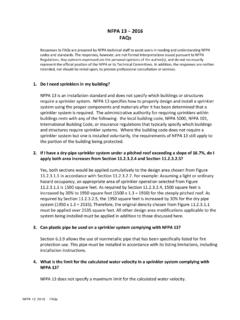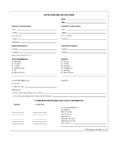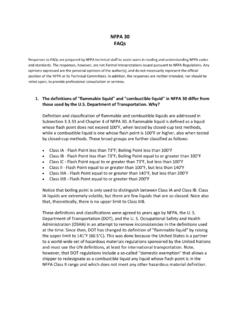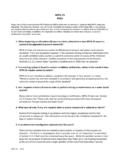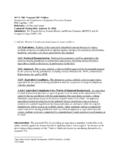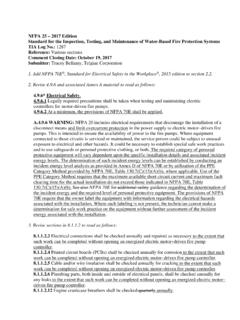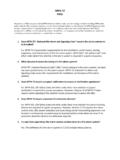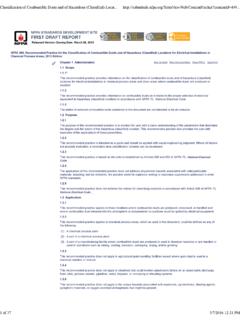Transcription of FOOD TRUCK SAFETY - NFPA
1 Philly Cheesesteaks Brick OvenBrick Oven10 ft10 ft10 ftBuildingFire Department AccessInterior ViewExterior ViewPropaneContainerPlan ViewSolid Fuel UseNOTE: Inspect all gas systems prior to each SHEETFOOD TRUCK SAFETY 2018 National Fire Protection AssociationNFPA code references are provided at the end of each item. The red keys correspond to the nfpa food TRUCK SAFETY diagram. For more detailed information, see nfpa 1 and Annex B in nfpa SAFETY Checklist Obtain license or permits from the local authorities. [1 (a)] G1 Ensure there is no public seating within the mobile food TRUCK . [1 ] G2 Check that there is a clearance of at least 10 ft away from buildings, structures, vehicles, and any combustible materials. [96 ; 96 for carnivals only] G3 Verify fire department vehicular access is provided for fire lanes and access roads.
2 [1 ] G4 Ensure clearance is provided for the fire department to access fire hydrants and access fire department connections. [1 ; 1 ; 1 ] G5 Check that appliances using combustible media are protected by an approved fire extinguishing system. [96 ] G6 Verify portable fire extinguishers have been selected and installed in kitchen cooking areas in accordance with nfpa 10. [96 ] G7a Where solid fuel cooking appliance produce grease-laden vapors, make sure the appliances are protected by listed fire-extinguishing equipment. [96 ] G7b Ensure that workers are trained in the following: [96 ]: G8 Proper use of portable fire extinguishers and extinguishing systems [10 ] G8a Proper method of shutting off fuel sources [96 ] G8b Proper procedure for notifying the local fire department [1 for carnivals only] G8c Proper procedure for how to perform simple leak test on gas connections [58 , 58 ] G8d TMNOTE: This information is provided to help advance SAFETY of mobile and temporary cooking operations.
3 It is not intended to be a com-prehensive list of requirements for mobile and temporary cooking operations. Check with the local jurisdiction for specific requirements. This SAFETY sheet does not represent the official position of the nfpa or its Technical Committees. The nfpa disclaims liability for any personal injury, property, or other damages of any nature whatsoever resulting from the use of this information. For more information, go to 2018 National Fire Protection Association / August 2018 FACT SHEET BECOME AN nfpa MEMBER FOR MORE OF THESE RESOURCESFuel & Power Sources Checklist Verify that fuel tanks are filled to the capacity needed for uninterrupted operation during normal operating hours. [1 for carnivals only] F1a Ensure that refueling is conducted only during non-operating hours.
4 [96 ] F1b Check that any engine-driven source of power is separated from the public by barriers, such as physical guards, fencing, or enclosures. [96 ] F2 Ensure that any engine-driven source of power is shut down prior to refueling from a portable container. [1 ] F3 Check that surfaces of engine-driven source of power are cool to the touch prior to refueling from a portable container. F3a Make sure that exhaust from engine-driven source of power complies with the following: F4 At least 10 ft in all directions from openings and air intakes [96 ] F4a At least 10 ft from every means of egress [96 ] F4b Directed away from all buildings [1 ] F4c Directed away from all other cooking vehicles and operations [1 ] F4d Ensure that all electrical appliances, fixtures, equipment, and wiring complies with the nfpa 70.
5 [96 ] F5 Propane System Integrity Checklist Check that the main shutoff valve on all gas containers is readily accessible. [58 (3)] P1 Ensure that portable gas containers are in the upright position and secured to prevent tipping over. [58 ] P2 Inspect gas systems prior to each use. [96 ] P3 Perform leak testing on all new gas connections of the gas system. [58 ; 58 ] P4 Perform leak testing on all gas connections affected by replacement of an exchangeable container. [58 ; 58 ] P5 Document leak testing and make documentation available for review by the authorized official. [58 (M)] P6 Ensure that on gas system piping, a flexible connector is installed between the regulator outlet and the fixed piping system. [58 (B)] P7 Where a gas detection system is installed, ensure that it has been tested in accordance with the manufacturer s instructions.
6 [96 ] P8 Operational SAFETY Checklist Do not leave cooking equipment unattended while it is still hot. (This is the leading cause of home structure fires and home fire injuries.) OA Operate cooking equipment only when all windows, service hatches, and ventilation sources are fully opened. [96 ; 96 ] OB Close gas supply piping valves and gas container valves when equipment is not in use. [58 ] OC Keep cooking equipment, including the cooking ventilation system, clean by regularly removing grease. [96 ] ODSolid Fuel SAFETY Checklist (Where Wood, Charcoal, Or Other Solid Fuel Is Used) Fuel is not stored above any heat-producing appliance or vent. [96 ] SA Fuel is not stored closer than 3 ft to any cooking appliance. [96 ] SB Fuel is not stored near any combustible flammable liquids, ignition sources, chemicals, and food supplies and packaged goods.
7 [96 ] SC Fuel is not stored in the path of the ash removal or near removed ashes. [96 ] SD Ash, cinders, and other fire debris should be removed from the firebox at regular intervals and at least once a day. [96 ] SE Removed ashes, cinders, and other removed fire debris should be placed in a closed, metal container located at least 3 ft from any cooking appliance. [96 ] SFFOOD TRUCK SAFETY CONTINUEDNFPA RESOURCES nfpa 1, Fire Code, 2018 EditionNFPA 1 Fire Code Handbook, 2018 EditionNFPA 58, Liquefied Petroleum Gas Code, 2017 Edition LP-Gas Code Handbook, 2017 EditionNFPA 70 , National Electrical Code , 2017 EditionNational Electrical Code Handbook, 2017 Edition nfpa 96, Standard for Ventilation Control and Fire Protection of Commercial Cooking Operations, 2017 EditionNFPA 96: Standard for Ventilation Control and Fire Protection of Commercial Cooking Operations Handbook, 2017 Editio
